A student was given 2 beakers labeled with numbers 1 and 2, each beaker contains a clear solution. Additionally, he was given two reagent bottles labeled with A and B. Now, he added reagent A to both beakers and he noticed the formation of a precipitate in beaker 2 but not in beaker 1. However, the addition of reagent B to both beakers resulted in the formation of a precipitate in beaker 1 but not in beaker 2. Based on the information, which of the following is correct? a. compound A is the limiting reactant in beaker 1. b. compound B is the limiting reactant in beaker 2. c. compound A is the limiting reactant in beaker 2. o d. compound B will be the excess reactant in beaker 1.
Ionic Equilibrium
Chemical equilibrium and ionic equilibrium are two major concepts in chemistry. Ionic equilibrium deals with the equilibrium involved in an ionization process while chemical equilibrium deals with the equilibrium during a chemical change. Ionic equilibrium is established between the ions and unionized species in a system. Understanding the concept of ionic equilibrium is very important to answer the questions related to certain chemical reactions in chemistry.
Arrhenius Acid
Arrhenius acid act as a good electrolyte as it dissociates to its respective ions in the aqueous solutions. Keeping it similar to the general acid properties, Arrhenius acid also neutralizes bases and turns litmus paper into red.
Bronsted Lowry Base In Inorganic Chemistry
Bronsted-Lowry base in inorganic chemistry is any chemical substance that can accept a proton from the other chemical substance it is reacting with.

Trending now
This is a popular solution!
Step by step
Solved in 2 steps









